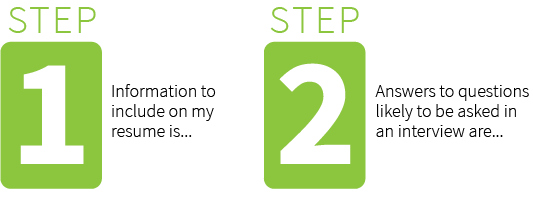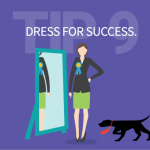Career Tip 10: Assemble Resume Details – Begin with the Interview in Mind
Begin with the Interview in Mind.
Creating your resume and preparing for an interview are so interrelated as to be the same activity. Assembling the details of your employment history, skills, and accomplishments is the first step in the construction of your resume. This process also prepares you for questions you are likely to encounter in an interview.
What you put in your resume also becomes the script for your interview.
What you put in your resume also becomes the script for your interview.

The Job Dog recommends you complete the list of items in both the Career History Worksheet and the Education and Skills Worksheet below before creating your resume.
Career History Worksheet
How much of your employment history should you include on your resume? The answer is as far back as your work experience builds the case that you are a qualified and unique applicant. Your most recent experiences should include a more in-depth presentation of your responsibilities and accomplishments. Early career experiences may end up on your resume with only the employer’s name, your job title, and dates of employment. However, preparing to answer in-depth questions about every job is worth your time – you never know when an interviewer may ask for a few early career details. Completing this exercise is a significant step in resume preparation – without the pressure involved with writing an actual resume.
- Name of employer or organization and contact information
- Employment dates – Complete in MM/YY format (01/07 – 11/13 etc.)
- Review company website – Doing so will help you to knowledgeably discuss the company. Develop a 15–25 word summary describing the organization and what they do. Even if the employer is well known, creating a precise, crisp description of their business will enable you to be highly prepared. Try to include a few numbers in your description: annual revenue, number of employees, number of people served per week/month, etc.
Example: DogPro produces high-quality dog food delivered directly to the consumer. Fifty employees make and deliver product to 1,500 homes; revenues are $5M annually.
See further examples in Tip 11.
- Job title – Include all job titles for this employer, with dates for each position held. At times, your actual job title may not accurately reflect your past role and responsibilities. While it is not appropriate to inflate or misrepresent your title, it is well within reason to modify a title to one that is both accurate and descriptive.
- Name(s) and job title(s) of the person (or people) to whom you reported
- Major duties or responsibilities for each position at this employer
- Accomplishments – List two to three measurable successes for each position at this employer. Quantify your results. While an employer is interested in where you worked and what you did, they are far more interested in what you accomplished.
- What you liked about the job – This question and the one following appeared on a Fortune 100 CEO’s list of her favorite interview questions.
- What you disliked about the job
- What you learned, skills acquired, core competencies developed – Pay particular attention to this question. Employers want to talk to candidates who use their jobs to develop contemporary skills and will hit the ground running.
- Reason(s) for leaving – Although you should not include this on your resume, this is a likely interview question.
A question about why you left a job can sometimes be difficult to answer. When you were let go, due to any number of reasons, we find that honesty, while also including a brief statement of the positive experiences, is the best approach. For example:After ten years of positive employment reviews from several supervisors, I began reporting to a new supervisor who did not value my work. Nothing in my work had deteriorated, yet from day one, she was sending signals about bringing in her own team. I was one of several people who were let go after she became manager.
Finally, to the extent possible, you want to communicate that you left a job for a better opportunity with a better company.
Limited Employment History?
If you are returning to the workforce (e.g., after being a stay-at-home parent or recently divorced) or are a recent college graduate, you likely will have limited work experience noteworthy enough to put on a resume. If that is the case, you may want to include part-time jobs as well as internships and volunteer activities.
Education & Skills Worksheet
General Guidelines
- If a high school diploma or a GED is your highest level of education, include that information.
- If you earned an Associate’s degree, you no longer need to include your high school education.
- We are often asked whether to list an Associate’s degree or time spent at a community college before a person earned a Bachelor’s degree. If you earned a Bachelor’s degree, include it at the top, and then if you have one, list an Associate’s degree beneath it. The Job Dog’s belief is that demonstrating you earned your way up the academic ladder is a real positive and demonstrates perseverance.
- If you have a graduate degree, list it first, followed by your Bachelor’s and Associate’s degrees.
- Degrees should always be listed on a resume from the highest level on down, with one exception: your most relevant degree that is required for a particular position should be listed first. For example, if you earned an Associate’s degree in Electronic Technology and you also hold a Bachelor’s degree in Education, if the job is in electronics, place your Associate’s degree at the top of the educational list.
- Always include ongoing or continuing education. For instance, even if you have a Master’s degree, if you returned to a community college to learn new software skills, a new language, or any new skill, list it. Today’s employers are keenly interested in applicants who upgrade and update. See Tips 2 and 4 for additional information on continuously improving yourself.
- One of the surest ways to stand out in a crowded field of applicants is to earn certifications in software proficiency relevant to your career field. Ongoing education is, in fact, mandatory today to maintain many professional credentials.
- High school & Associate’s/technical degrees or certifications
- Bachelor’s degree(s)
- Post graduate degree(s)
- Continuing education courses at/through work
- Continuing education courses, self-directed
- Software knowledge
- Foreign languages and level of proficiency
- Military service
- Community or volunteer service activities
This Tip not only prepares you to develop your resume, it also helps you create the foundation for successful interviews.
Being better prepared than others gives you the advantage.
Being better prepared than others gives you the advantage.
As we said earlier, since it takes time to develop thoughts and details regarding your employment history, The Job Dog encourages you to begin collecting this information early in your career transition process. A recent client told The Job Dog that, after he used this Tip, his new boss said he got the job because his interview answers were light years ahead of other candidates. Be prepared.
Checkpoint
Discuss this information with a few other people who can offer useful feedback. Having multiple conversations about your answers to these questions will further clarify your thoughts and prepare you for upcoming interviews.










